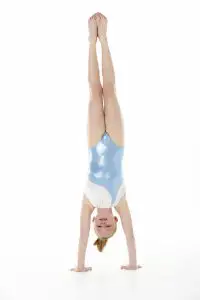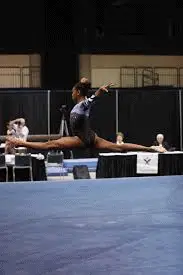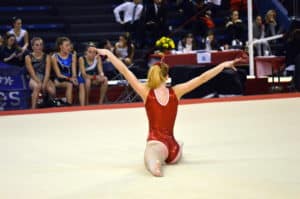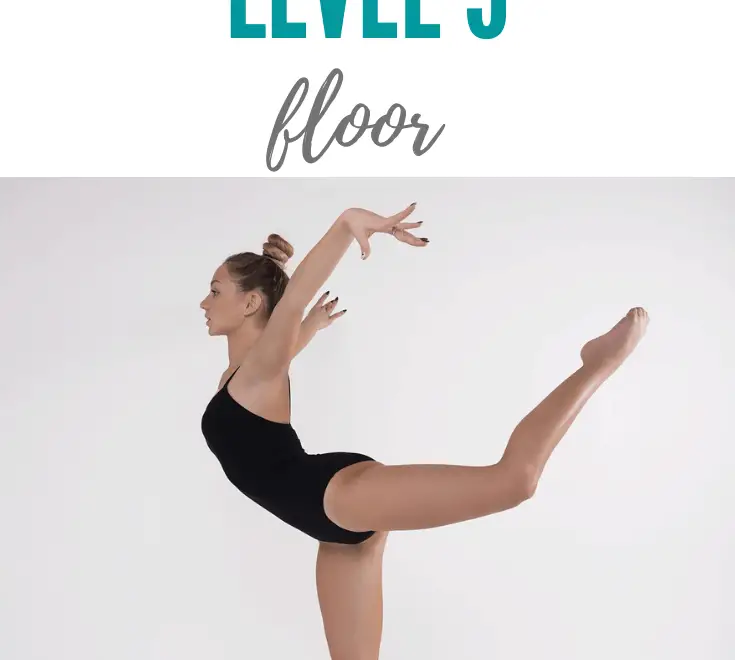This post has been updated to reflect the 2021-2029 compulsory routine changes, and was updated again in July 2023.
The final compulsory floor routine is the Level 5 floor routine. This routine is full of progressions from the Level 4 routine, and helps gymnasts learn the skills necessary to become a successful optional gymnast. It’s tough to do the Level 5 floor routine well! It’s well worth it to put the time in to clean it up, though.
What the Judges Look for in a Level 5 Floor Routine
To maximize the score of a Level 5 floor routine, here are three categories to work on, in order of importance:
- Execution on major elements
Are they performed well, with straight legs, straight arms, tight body positions?
Do leaps, jumps, and hops have good amplitude?
- Are the major elements free from specific element deductions (more details below)?
Has attention been paid to the smaller details (kicks, arm positions, foot faults)? - Has the gymnast minimized her deductions in the general categories (text, rhythm, artistry, posture, etc.)?
The goal is to be able to answer YES to each of these questions. Now, let’s look at how these categories break down.
Level 5 Floor Skills
Each skill in the Level 5 floor routine has specific deductions for each skill. These deductions relate to the technique that is expected for the skill. In addition to these deductions, there are general execution deductions that judges can apply to all skills. We’ll talk more about those in a minute. Finally, a judge can take general routine deductions, which are deductions for the overall impression of the routine. If you’re curious about that, here’s an article that discusses general deductions in detail.
The following skills are considered “major elements” in the Level 5 floor routine. Major elements are the “big” skills in the routine, and they are the skills that are worth the most points. General execution deductions apply to all major elements in the routine.
The Level 5 floor skills are:
- Front tuck OR
Aerial cartwheel OR
Aerial walkover forward - Front handspring step-out, front handspring step-out, cartwheel, straight arm backward roll to handstand
- Stretch jump 1/1 turn
- Split leap OR
Switch leg leap - Straddle jump
- Forward split
- Full turn
- Roundoff, flic-flac, back salto tucked
Next, we’ll take a look at general execution deductions that apply to these major elements.
General Execution Deductions
General execution deductions are ones that can be taken on any major element in a compulsory routine. Here is a list of general execution deductions that could be taken during a floor routine:
- Foot form – 0.05
- Additional running steps into forward tumbling pass – maximum 0.05
- Leg separation – Up to 0.20
- Body alignment/position/posture in major elements – Up to 0.20
- Bent arms or legs (max deduction at 90 bend) – Up to 0.30
- Balance errors – Up to 0.30
- Fall (on or off the apparatus) – 0.50
- Failure to mark the passe position in releve at turn completion – 0.05
- Failure to contract or extend when indicated – Up to 0.10
- Leg swing/kick not to horizontal or above when required – Up to 0.10
- Uneven leg separation in leaps/jumps – Up to 0.10
- Failure to perform turns in high releve – Up to 0.10
- Failure to keep arms by ears while moving in and out of slow acro elements – 0.05 each
- Not finishing with the music – 0.10
- Failure to land with feet together on 2-foot landing of jumps – Up to 0.10
- Insufficient split – Up to 0.20
- Stop between elements in an acro series on floor – 0.30
- Extra kick to handstand – 0.30
Technique Changes for the 2021-2029 Compulsory Cycle
If you’ve coached prior to 2021, you’ll notice that these are different from past compulsory routines, but there are more options now to allow for flexibility in coaching techniques. Win-win for everyone!
Specific Execution Deductions
Beginning Pose and Dance Sequence
The routine starts with a kick, lunge choreography sequence. This kick must reach horizontal or higher. General deductions will apply to the choreography sequence. For instance, there is a deduction of up to 0.10 for failure to kick to horizontal or above when that is the requirement.
Front tuck salto OR Aerial cartwheel OR Aerial walkover
Front tuck salto
Again, there is no requirement for number of steps into the front tuck. The tuck position should achieve at least 135° knee and hip bend, but ideally 90°. If the tuck position is insufficient, up to 0.20 deductions for each (hips and knees) will apply. There is an additional up to 0.60 deduction for performing the salto in a different body position (pike or layout). General deductions apply for insufficient height (up to 0.30), leg separation (up to 0.20), foot form (0.05), poor posture on landing (up to 0.20), and landing deductions such as steps (0.10 each), falls (0.50), or a deep squat (up to 0.30).
Aerial Cartwheel
The aerial cartwheel should be performed from a step hurdle. The only specific deduction is up to 0.30 if the gymnast does not pass through vertical.
General deductions that could apply to the aerial cartwheel are insufficient height (up to 0.20), bent legs (up to 0.30), foot form (0.05), and body position (up to 0.20). There is no deduction for insufficient split during the aerial cartwheel.
The aerial cartwheel should finish, landing one foot at a time, into a lunge or a straight stand.
Aerial Walkover
The aerial walkover should be performed from a step hurdle. There are no specific deductions for this skill, but general execution deductions apply.
General deductions that could apply to the aerial walkover are insufficient height (up to 0.20), bent legs (up to 0.30), foot form (0.05), and body position (up to 0.20). There is no deduction for insufficient split during the aerial walkover.
The aerial walkover should finish, landing one foot at a time, into a straight stand.
Chaine turn, Lunge, Pivot turn, Poses
This choreography sequence does not contain any major elements. This means that general deductions apply (link). The emphasis should be on footwork, posture, and correct arm positions.
Front handspring stepout, Front handspring stepout, Cartwheel, Back extension roll

Front handspring step-out, front handspring step-out
The gymnast can perform a power hurdle or a step hurdle into the front handsprings with no deduction. If she performs additional steps, it is a 0.05 deduction regardless of the number of steps. If she joins her legs together before the step-out, she will lose 0.10 each time, and 0.20 each if she never steps out.
There are also some deductions that apply to the technique of the front handsprings. If she dives into the front handspring (as shown by flight before her hands touch the floor), she will receive an up to 0.20 deduction. Using alternate hand placement will result in a 0.10 deduction.
There is no deduction for lack of repulsion during the front handsprings. It is acceptable to perform a “fast front walkover” technique. The goal is to teach acceleration in preparation for front tumbling passes. There is an up to 0.20 deduction for lack of acceleration.
General deductions also apply for errors such as bent arms, bent legs, and foot form.
Cartwheel
The cartwheel should be performed continuously after the second front handspring step-out. The entrance can be either a lunge or a mountain climber entrance.
The gymnast should pass through vertical on the cartwheel (up to 0.30) and keep her head in line with her body (up to 0.10). If her hands are placed on the ground at the same time, it is a 0.10 deduction.
General deductions apply for errors such as bent arms, bent legs, poor body posture, foot form, and failure to keep the arms by the ears.
The cartwheel should end with a step-in finish, in preparation for the back extension roll. The gymnast can finish in a straight stand, or she can maintain a rounded body shape and move immediately into the back extension roll.
Backward roll to handstand
Another name for a backward roll to handstand is a back extension roll.
The back extension roll must be performed with straight arms, or an up to 0.30 deduction can be applied. If the gymnast places the hands on the floor as she rolls back, she would get a flat 0.30 deduction. Both a tucked or piked entry are allowable into the back extension roll.
A 0.10 deduction would apply if the hands are wider than shoulder-width apart, and another 0.10 applies if the fingers are interlocked.
The roll must go through a handstand position, with an up to 0.30 deduction if the roll does not hit vertical. If the gymnast performs a backward roll stepout, she would receive a flat 0.40 deduction for changing the element. The handstand does not need to be held. The gymnast is expected to keep the arms by the ears as she moves out of the roll (0.05 deduction).
It’s common to see body position errors (pike or arch – up to 0.20) or leg separations (up to 0.20) during the back extension roll.
The back extension roll can finish in a lunge, or use a step-in technique, where the gymnast steps in to finish with straight legs and feet together.
Straight jump 1/1 turn
The stretch jump 1/1 turn can also be called a straight jump 1/1 turn, or simply a jump 1/1 (full) turn.
Before the jump 1/1 turn, there is a series of dance poses. These are not major elements, but the gymnast can get deductions for footwork, posture, text errors, or failure to kick to horizontal. The step, kick, and forced arch pose should all be performed in high releve.
During the jump ½ turn, the emphasis is on height (up to 0.20) and posture (up to 0.20). Other common deductions are for bent legs (up to 0.30), foot form (0.05), and body position during the jump (up to 0.20).
In addition, there are specific element deductions for failure to land with the feet together (up to 0.10), failure to land on both feet at the same time (0.10), and for failure to keep legs together in the air during the jump ½ turn (up to 0.10).
The gymnast should bring the arms into crown during the jump. The jump ½ turn finishes with a small rebound to one knee. The arms remain in crown during the rebound.
Backward passe hop, Side chasse, Passe hop turn, Forward chasse, Straight leg leap OR Switch leap

The book actually splits this series into two parts, but it is all connected, so I left it as one sequence here.
The leap is the only skill in this series that is considered a major element, so the other skills would be subject to general deductions. Also, if one of these elements is inadvertently omitted, it would only be a small deduction.
During the hops and chasse’s, the gymnast should focus on leg and foot position, posture, and arms in the correct positions. All of these areas are subject to general deductions if they are performed incorrectly.
There is an option to perform either a straight leg leap or a switch-leg leap, worth the same value. If the gymnast bends the front leg on either the leap or switch leap, she will receive a deduction of up to 0.10. On the switch leap, the first leg must swing to at least 45°, or a 0.10 deduction is applied. The last specific deduction is up to 0.20 for uneven split (one leg higher than the other).
The leap (or switch leap) should achieve a 150° split (up to 0.20 deduction). Other general deductions that often apply to the leap pass include lack of height (up to 0.20), poor posture (up to 0.20), bent legs (up to 0.30), and foot form (0.05).
The gymnast can place her arms in one of three positions: opposition, side-middle, or forward middle opening to side-middle. The arms should stay in position during the leap and at the finish of the leap (text error if they do not).
Straddle jump
During the straddle jump, the arms should be sideward diagonally upward, and move to crown on landing. Side-split and straddle-pike positions are both acceptable with no deduction.
The straddle jump should achieve a minimum of a 150 leg separation (up to 0.20 deduction). Just like the other leaps and jumps, the emphasis is on height (up to 0.20) and posture (up to 0.20). Deductions apply for leg and foot form.
In addition, there are specific element deductions for uneven split (up to 0.20), failure to land with the feet together (up to 0.10) and failure to land on both feet at the same time (0.10).
Forward split

Next, the gymnast performs a series of poses in kneeling and sitting, including a sitting turn. The final kneeling pose brings the arms to crown, then they lower to side-middle during the split.
General deductions apply for posture, feet, and bent knees during the split. If the split is not at 180 degrees, a deduction of up to 0.20 can be applied.
After the split, the gymnast moves into a prone position and performs a prone spin/log roll turn to stand.
Full turn
Prior to the turn, the gymnast performs a lock position with windmill arms.
Next, the gymnast points the foot in front. She can choose between the acceptable turn preparations listed in the Compulsory Handbook. If she uses a heel-snap turn technique, the deduction is 0.30. The free leg should be in forward passe (0.10 deduction).
Deductions can also be applied for failure to perform the turn in high releve (up to 0.10) and incomplete turn (up to the value of the element – up to 0.40), as well as posture (up to 0.20) and foot form (0.05).
The full turn is completed by stepping into another lock position. There is another choreography sequence before the final tumbling pass.
Roundoff, back handspring, back salto tucked
During tumbling passes, the gymnast must accelerate her speed as she moves into each successive skill. If the gymnast does not show acceleration throughout the series, she could receive a deduction of up to 0.20. If there is a stop between elements in an acro series/tumbling pass, a 0.30 deduction is applied each time.
Roundoff
The gymnast may run any number of steps into the tumbling pass with no deduction. The roundoff should land on both feet at the same time, or a flat 0.10 deduction can be taken. If she does not pass through vertical, up to 0.30 can be deducted.
Additional deductions could be applied for bent arms (up to 0.30), bent legs (up to 0.30), and incorrect body position (piked or loose arch position – up to 0.20 each).
Flic-flac
Another common name for flic-flac is back handspring. You might sometimes see them abbreviated as flic-flac (FF) or back handspring (BHS). Some people also call a flic-flac a flip-flop.
The gymnast should punch into the back handspring without squatting, or an up to 0.20 deduction can be applied each time. Again, a flat 0.10 deduction can be taken if she does not land on two feet at the same time in the back handspring.
Just like the roundoff, deductions apply for bent arms, bent legs, and incorrect body position (piked or loose arch position).
Back salto tucked
Most of the time, you will hear the backward salto tucked referred to as, simply, a back tuck.
The gymnast should maintain the tuck position throughout the salto, or flip. If shd performes a pike or layout, she will receive an up to 0.60 deduction. She should extend, or open, her body before she lands, or an up to 0.20 deduction can be applied. The back tuck should finish in a “stick” position with control (0.05 deduction).
Other common deductions are lack of height (up to 0.30), poor posture on landing (up to 0.20), leg separation (up to 0.20), and foot form (0.05).
If the gymnast takes extra steps or has balance errors after her tumbling pass, she will receive deductions for each step (0.10 each) or balance error (up to 0.30).
General Deductions in the Level 5 Floor Routine
During the choreography components of the Level 5 floor routine, also called non-value parts (or non-VP’s), general deductions are used. Judges make notes of small errors during the routine in each of the general categories, and determine a total deduction after looking at the routine as a whole.
General deductions on floor consist of the following:
- Text errors – up to 0.30
In the compulsory handbook, this is described as “incorrect position of head, arms, legs, or feet”. - Artistry – up to 0.30
This deduction is broken down into two parts: up to 0.15 for quality of the gymnast’s movement to reflect the choreography, and up to 0.15 for quality of expression, including projection, emotion, and focus. - Rhythm – up to 0.20
Rhythm deductions are taken for not performing the routine in time with the music, or performing a section with incorrect rhythm compared to what is listed in the text.. An additional 0.10 can be taken if the gymnast does not end the routine in time with the music. - Posture: up to 0.30
This can be applied for any postural errors during choreography, such as ribs out, bottom out, head forward, shoulders slumped, etc. - Footwork – up to 0.30
Feet should be pointed anytime they leave the ground, and the gymnast should stand and step in releve when indicated. She should also show turn-out in her foot positions. - High releve: up to 0.20
Gymnast should perform steps and pivot turns in high releve throughout the routine, when indicated.
For more information on general deductions, see this post.
Final Thoughts on Level 5 Floor
Level 5 floor, just like the other Level 5 routines, is difficult to perform well, but it is beautiful when done correctly. The techniques learned during this routine will be helpful when moving on to optional levels. What’s the toughest part of this routine? Do you have any favorite drills for the Level 5 floor skills?
Further Reading
How to Perform the Best Level 5 Beam Routine
How to Perfect Your Level 5 Bar Routine
5 Tips for a Stellar Handspring Vault
Preview of 2021-2029 Compulsory Skills
General Categories for Exemplary Compulsories
The Best Gymnastics Mats for Home
The Best Gifts for Gymnasts (and Coaches!)
References
USA Gymnastics Compulsory Handbook, 2021-2029.
